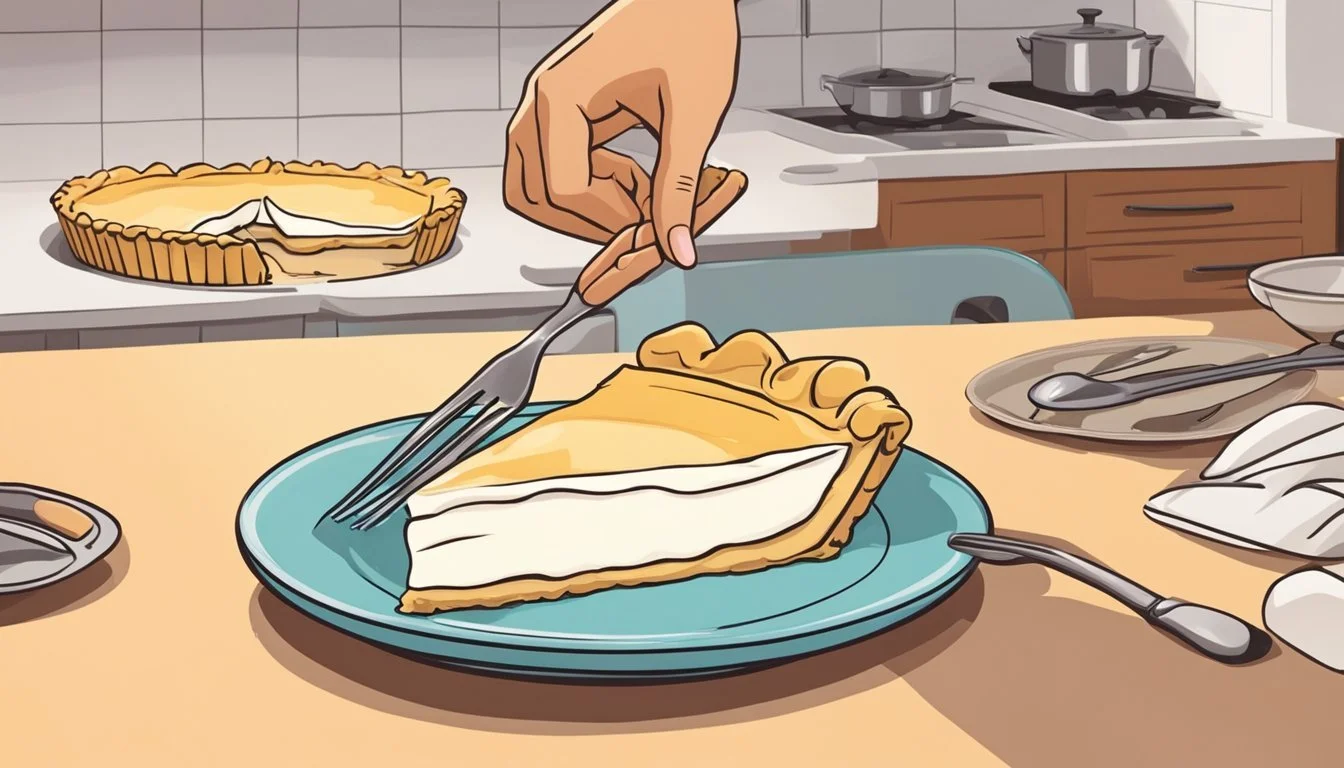How Long Do Fresh Cream Pies Last?
Shelf Life and Storage Tips
When it comes to savoring the decadent flavors of fresh cream pies (how long do fresh cream pies last?), understanding their shelf life is essential. These delightful desserts typically consist of a pastry crust filled with various sweet, creamy concoctions. Fresh cream pies, including favorites such as chocolate cream, banana cream, and coconut cream, are especially popular for their luscious texture and rich taste. However, the freshness of the ingredients, especially dairy-based components, means these pies are more perishable than their fruit-based counterparts.
The longevity of fresh cream pies in the refrigerator is generally limited. For optimal taste and safety, these pies should be consumed within a brief time frame after preparation. Refrigeration slows down the microbial growth that can lead to spoilage or foodborne illness. Cream pies are typically safe to eat when stored in the refrigerator for up to 48 hours, provided they’re covered properly to prevent the absorption of other flavors and to maintain moisture levels.
The proper storage technique for fresh cream pies involves covering them with plastic wrap or foil to protect the delicate meringue or whipped cream toppings from losing their texture. An additional consideration is the avoidance of strong odors in the refrigerator, which can be absorbed by the pie, altering its intended flavor profile. It's also recommended to keep the pies away from any raw meat or strong-smelling food items to maintain their intended taste.
Overview of Pie Preservation
Preserving pies appropriately is essential for maintaining flavor, quality, and safety. Different types of pies have varying shelf lives and storage requirements.
Fruit Pies: These include apple, cherry, and peach pies, which can typically stay fresh at room temperature for up to two days due to their acidic content that helps deter spoilage. In the refrigerator, these pies usually last 3-4 days.
Cream and Custard Pies: Cream pies, such as coconut cream pie, lemon meringue, and custard-based pies like pumpkin and sweet potato pie, need refrigeration due to their egg and dairy content. They can last for 1-2 days in the fridge.
Pecan and Chiffon Pies: These should also be refrigerated and tend to last a similar time as cream pies. Pecan pie, however, may last a little longer due to its high sugar content, which acts as a preservative.
Freezing Pies: Fruit and pecan pies freeze well for up to six months. Before freezing, it's advised to first freeze the pie uncovered and then wrap it securely to avoid freezer burn.
Cream pies should be covered to prevent absorption of other flavors.
To revive a refrigerated pie, reheating in a 350°F oven for about 15 minutes is recommended.
Always ensure pies are cooled to room temperature before refrigeration to prevent condensation, which can make
Storing Fresh Cream Pies
Proper storage is crucial for maintaining the quality and freshness of cream pies. Here are best practices for refrigeration and tips for freezing these delicate desserts.
Refrigeration Best Practices
When storing fresh cream pies in the refrigerator, it's important to allow the pie to cool completely before storing to prevent the accumulation of moisture, which can lead to a soggy crust. To refrigerate a cream pie:
Place wooden toothpicks into the meringue to prevent plastic wrap from sticking.
Loosely drape plastic wrap over the toothpicks to protect the topping.
Store the pie on a shelf, away from strong-smelling foods that could transfer flavors.
Custard and cream pies should be refrigerated as soon as they have cooled and can typically be kept for up to 2 days. For best results, they should be stored in an airtight container to shield them from other flavors and to maintain freshness.
Freezing Techniques
Freezing cream pies is generally not recommended due to the delicate nature of their fillings, which may separate or become watery upon thawing. However, if you must freeze a cream pie:
Ensure it is completely cool before attempting to freeze.
Wrap the pie tightly with plastic wrap, then with foil to prevent freezer burn.
Place the wrapped pie in an airtight container to protect it from absorbing any odors.
To thaw frozen cream pies, one should transfer them to the refrigerator and allow them to defrost slowly for several hours or overnight. It's important to note that texture and flavor may be compromised after freezing.
Factors Affecting Shelf Life
The longevity of a fresh cream pie is influenced by several key factors, including the nature of its ingredients, how it is stored, and the manner in which it is packed. Understanding these can help maximize a pie's shelf life.
Ingredients and Their Impact
Dairy: Cream pies contain dairy products that are highly perishable and can spoil quickly.
Eggs: Fresh cream pies often rely on eggs, which are prone to bacterial growth if not refrigerated properly.
Fruit: If fruit is included, its acidity and moisture content can affect shelf life, sometimes mitigating bacterial growth.
Crust: A moist or soggy crust can be a sign of spoilage; crispy crusts generally indicate a fresher pie.
External Storage Conditions
Temperature: Pies should be stored in a cool, consistent environment, typically in a fridge set below 40°F (4°C).
Humidity: High humidity levels can make pie crusts soggy and accelerate spoilage, especially in cream pies.
Time: The longer a fresh cream pie is kept, even under ideal conditions, the more its quality will deteriorate.
Packaging and Protection
Pie Crusts and Dough: Fresh pie dough and baked pie crusts benefit from being wrapped in materials like plastic wrap or aluminum foil to minimize exposure to air.
Filling: Protective coverings are crucial not only for maintaining the structural integrity of the pie but also for preventing the formation of a skin on the filling, especially if it's a custard-based one.
Whipped Cream: If topped with whipped cream, ensure it's fresh and covered, as it can quickly become a medium for bacteria.
Health and Food Safety Considerations
When considering the longevity and safety of fresh cream pies, one must adhere strictly to food safety guidelines to prevent foodborne illnesses, as these products are highly perishable. Recognizing the state of the pie is crucial in determining its safety for consumption.
Food Safety Guidelines
The U.S. Department of Agriculture (USDA) along with the Food and Drug Administration (FDA) provide specific recommendations for storing perishable items like fresh cream pies. The emphasis on keeping these pies refrigerated is due to their high risk of spoilage. After preparation, fresh cream pies should be:
Promptly refrigerated at a temperature lower than 40°F (4°C) to slow down bacterial growth.
Stored properly in the fridge, consumed, or discarded within 4 days for optimal freshness and food safety.
It is not recommended to freeze fresh cream pies as the texture and consistency of the cream may be adversely affected, leading to a decline in quality.
Recognizing Spoilage
Identifying when a fresh cream pie has gone bad is pivotal in preventing the consumption of potentially hazardous food. Signs of spoilage can include:
Visible mold growth on the surface of the pie, which may appear as fuzzy discolorations.
An off smell is a strong indicator that the pie should not be consumed.
Taste changes should be noted, although it's advisable to avoid tasting if the pie shows other spoilage signs.
Texture changes such as a soggy crust or separation of the cream can also suggest spoilage.
Consumers should trust their senses and err on the side of caution, disposing of any pie that seems questionable in quality.
Preparation and Usage Tips
Proper preparation and reheating are crucial for enjoying fresh cream pies at their best. One must follow specific steps to maintain the quality and flavor of the pie from the oven to the table.
Defrosting and Reheating
When a cream pie has been stored in the freezer, it must be thawed properly before reheating. To defrost, transfer the pie from the freezer to the refrigerator and let it thaw overnight. To reheat a defrosted or refrigerated cream pie, one should place it in an oven preheated to 350°F (175°C) and warm it for 10-15 minutes. Using a microwave for reheating is not recommended, as it can unevenly heat the pie and affect the texture of the fresh cream.
Baking Recommendations
For baking fresh cream pies, preheat the oven according to the recipe's instructions. Generally, baking temperatures range from 325°F to 375°F (163°C to 190°C), depending on the recipe. Always use an oven thermometer to ensure accuracy. It is essential to bake the pie until the filling is set and the crust is golden brown. Cooling the pie on a wire rack ensures even air circulation and helps avoid a soggy crust.
Prepare kitchen surfaces and gather all necessary utensils before beginning to bake.
Follow the pie recipe closely to ensure the correct meal proportions and baking times.
After baking, let the pie cool completely before topping with fresh cream to prevent it from melting.
By adhering to these tips, one can prepare and serve a delicious cream pie that retains its intended flavor and texture.
Miscellaneous Pie Storage Insights
Storing pies correctly extends their shelf life and ensures they remain safe for consumption, whether they are sweet or savory leftovers. Different pies require varying storage methods due to their ingredients.
Pies as Leftovers
After a gathering such as Thanksgiving, it's common to have pie leftovers. Fruit-filled pies, like apple or cherry, can usually be stored in the refrigerator for 3-4 days. They can also be frozen for longer storage. To freeze, one should let the pie cool, place it uncovered in the freezer, and once frozen, transfer it into a plastic freezer bag for future delight.
Savory pies, which may contain meat, should be treated with similar caution as they can be a fertile ground for bacteria if left at room temperature for too long. Leftover savory meat pies should be promptly refrigerated and are best consumed within 3-4 days.
Specialty Pie Considerations
Pies with more delicate components like mousse, whipped cream, or meringue typically have a shorter refrigerator shelf life. These types should ideally be consumed within 1-2 days to maintain optimal taste and texture, and they must always be chilled due to their dairy and egg content.
During occasions like Thanksgiving, storing pie is a concern, especially when dealing with meringue or whipped cream toppings. These pies should not remain unrefrigerated for more than two hours. It's best to serve them chilled to maintain the integrity of the topping and prevent potential foodborne illness.
Conclusion
Maintaining the quality of a fresh cream pie relies heavily on proper storage techniques. According to expert advice, store-bought pies and those made at home have a similar shelf life when stored correctly. A cream pie generally retains its freshness in the refrigerator for:
Banana Cream, Coconut Cream, and similar varieties: Up to 48 hours
It is pivotal for consumers to store cream pies in the refrigerator immediately after purchase or preparation. For optimal taste, they should consider consuming a fresh cream pie within this timeframe.
To further preserve the integrity of these desserts, they should be:
Stored in an airtight container
Kept at a consistent, cool temperature
Shielded from strong odors that could be absorbed
For any cream pie aficionados considering freezing these treats, doing so may affect the texture and taste, as cream pies typically do not freeze well. They may find that the crust becomes soggy and fillings may separate upon thawing.
In summary, the enjoyment of a cream pie in its finest state requires prompt consumption and rigorous adherence to recommended storage practices.









